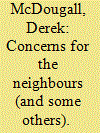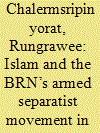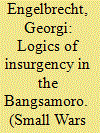|
|
|
Sort Order |
|
|
|
Items / Page
|
|
|
|
|
|
|
| Srl | Item |
| 1 |
ID:
183461


|
|
|
|
|
| Summary/Abstract |
The study of child soldier recruitment and its wider impact has grown rapidly since the early 1990s and led to a steady flow of research, media commentary, and important multilateral treaties. There are still, however, important gaps in the literature. Scholarly work has tended to be either microscopic or panoramic, both as narrow single-case studies or comprehensive quantitative research. The range of topics has been broad, and also reflects its multi-disciplinary nature, comprising area studies, child and adolescent psychology, criminology, development studies, gender studies, health and trauma studies international law, international relations, social anthropology, and more. The studies vary from broad introductory works to survivor narratives, interviews and surveys, discussions on recruitment and international humanitarian law, as well as works on demobilization, disarmament and rehabilitation (DDR). Collectively, it constitutes an ad hoc, patchwork body of literature, presenting challenges for newcomers to the field, and much of it confined to soft topic terrain despite its socially destructive and norm-shifting effects.
|
|
|
|
|
|
|
|
|
|
|
|
|
|
|
|
| 2 |
ID:
183460


|
|
|
|
|
| Summary/Abstract |
Focusing on the conflicts in the Southern Philippines and West Papua, this article uses a framework developed from the literature on the internationalisation of ethnic conflict to suggest insights into international involvement in both conflicts. In both cases there are succinct overviews of the relevant general background to the conflict, and international involvement in particular, followed by a characterisation in terms of typological features that covers motives for involvement, objectives, means of involvement, and impact. Insights into international involvement in the two conflicts can suggest ways in which aspects of the general literature might be developed further, but two cases are insufficient to develop more broad ranging generalisations. A key insight is the way in which specifically political factors can affect the way in which motives for involvement manifest themselves, the significance of Sabah politics in relation to Malaysian involvement in the Southern Philippines, and West Papuan lobbying in the Melanesian countries being cases in point.
|
|
|
|
|
|
|
|
|
|
|
|
|
|
|
|
| 3 |
ID:
183456


|
|
|
|
|
| Summary/Abstract |
Indonesia invaded East Timor in 1975 and occupied it for the next 24 years with the military and diplomatic support of major powers. Despite its insistence that its annexation was irreversible, Indonesia was forced to withdraw in 1999, resulting in an independent East Timor. This article explains how the 24-year war against East Timor ended by analysing the three pillars on which Indonesia’s control rested: its military superiority over the East Timorese resistance; the support of the international community; and its determination to retain the territory. Indonesia’s overwhelming military superiority persisted until the very end. East Timorese resistance and international solidarity weakened international support for the occupation. Indonesia’s determination to retain the territory underwent a complete reversal over the course of 1999. The East Timorese resistance was successful although they lacked a land border with a friendly state, an external supplier of weapons, or a liberated area in which to recover between guerrilla operations.
|
|
|
|
|
|
|
|
|
|
|
|
|
|
|
|
| 4 |
ID:
183455


|
|
|
|
|
| Summary/Abstract |
The Westphalian system provides the global context of international relations within which the recent and contemporary ‘small wars and insurgencies’ of Maritime Southeast Asia have developed. Usually dated to the Peace of Westphalia in 1648, ending the Thirty Years’ War in Europe, the Westphalian system located sovereignty in states, following the principle of cuius regio, eius religio (whose realm, their religion). This system replaced arrangements where sovereignty was more mixed, leading at times to conflict over the location of authority.
|
|
|
|
|
|
|
|
|
|
|
|
|
|
|
|
| 5 |
ID:
183459


|
|
|
|
|
| Summary/Abstract |
This article examines the roles of religion in the contemporary separatist movement in southern Thailand, whose violent campaigns have dramatically surged since 2004. It locates Islam in the region’s own political and historical context rather than viewing it as an expression of transnational terrorism or casting Islam as of secondary importance in what is seen as primarily an ethno-nationalist struggle, as some scholars have done. I argue that Islam served as a powerful motivational frame that drove thousands of Malay Muslims to take part in the violent struggle led by the Patani Malay National Revolutionary Front (BRN), as a sacred justification for their violent actions and as a blueprint of a new socio-political order. The conflict was elevated into a cosmological battle and the fighters’ actions were fundamentally framed within Islamic theology. Islamic law was employed as a primary reference for the justification and regulation of violent attacks. This article also demonstrates that Islam is part of the BRN’s political agenda and fighters have turned their perceived Islamic beliefs and norms into military actions. However, its ideological orientation is at variance with that of the transnational jihadists. This article offers a more nuanced approach to understanding the religious dimensions of this conflict.
|
|
|
|
|
|
|
|
|
|
|
|
|
|
|
|
| 6 |
ID:
183457


|
|
|
|
|
| Summary/Abstract |
Over sixty years of conflict in the Southern Philippines, between the government and separatist groups, have made Mindanao and the Sulu Archipelago an area prone to violence. Armed groups in Bangsamoro and their historical antecedents have often local origins. Even the original rebellion of the Moro National Liberation Front (MNLF) from which the Moro Islamic Liberation Front (MILF) emerged, the largest rebel force in the area and current leader of a transition government in the Bangsamoro, was a coalition of armed elements across Mindanao that organized together before becoming a stronger united front. The following article will describe the evolution of the armed rebellion in Mindanao and analyse its subsequent trajectory, proposing four reinforcing lenses to understand the various Moro insurgencies and explain local splintering and contradictions within the rebel movement.
|
|
|
|
|
|
|
|
|
|
|
|
|
|
|
|
| 7 |
ID:
183458


|
|
|
|
|
| Summary/Abstract |
This article explores three interrelated components of the independence movement in Papua – armed resistance, political struggle, and international lobbying. As an insurgency, the armed resistance in Papua is local, sporadic and does not threaten Indonesian control. Indonesia’s predominantly military response to both armed and peaceful resistance has given violence a greater significance in the Papua conflict than the capacity of the armed resistance groups would suggest. The significant Indonesian military deployment and the associated human rights abuses have provided ammunition for pro-independence international lobbying. Notwithstanding a highly constrained political environment, activists continue to demonstrate after nearly 6 decades of Indonesian rule the capacity to mobilise support for independence harnessing issues such as racism. The article examines the Government’s dilemma that the means it has chosen to sustain its authority – an overwhelming military superiority – is one of the factors that fuels Papuan support for independence. What form of governance is possible in democratic Indonesia, when a portion of Papuan society does not consent to Indonesian rule?
|
|
|
|
|
|
|
|
|
|
|
|
|
|
|
|
|
|
|
|
|